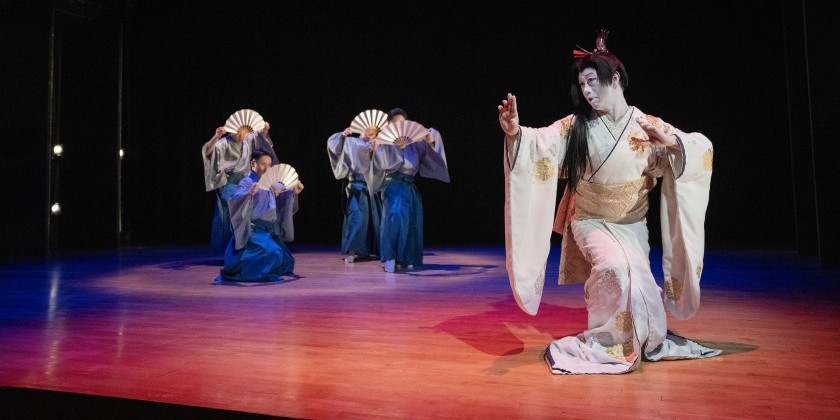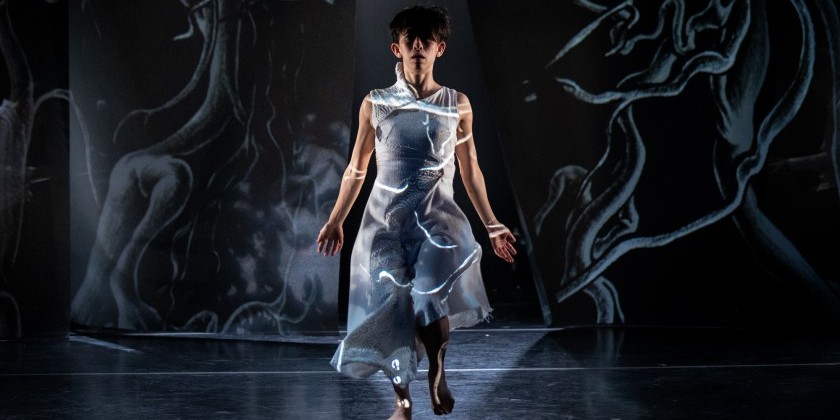IMPRESSIONS: Nihon Buyō in the 21st Century from Kabuki Dance to Boléro at Japan Society

Matsuri (Festival)
Arrangement by Tosha Yukimaru // Hayashi-kata (Percussion): Tosha Yukimaru, Tosha Rokon //Fue (Flute): Tosha Suiho
Toba-e
Servant Masuroku: Hanayagi Motoi (January 24-25); Hanayagi Genkuro (January 26)
Mouse: Hanayagi Suzuhiko // Chanters: Kiyomoto Kiyomidayu, Kiyomoto Ichitayu //Shamisen: Kiyomoto Eikichi // Hayashi-kata (Percussion): Tosha Yukimaru, Tosha Rokon // Fue (Flute): Tosha Suiho
Yugiri, the Courtesan
Chanters: Kiyomoto Kiyomidayu, Kiyomoto Ichitayu // Shamisen: Kiyomoto Eikichi
Hana (Flower)
Composer and arranger: Tosha Suiho
Ko-tsuzumi (Small hand drum): Tosha Rokon // O-tsuzumi (Large hand drum): Tosha Yukimaru
Fue (Flute): Tosha Suiho
Boléro ~The Legend of Anchin and Kiyohime
Conception: Hanayagi Juo II // Director and Choreographer: Hanayagi Genkuro // Music: Maurice Ravel
Kiyohime: Azuma Tokuyo (aka. Nakamura Kazutaro) //Ensemble dancers: Azuma Kansai, Hanayagi Suzuhiko, Fujima Naozo, Fujima Ryotaro
January 24 - 26, 2024
Nihon Buyō in the 21st Century from Kabuki Dance to Boléro, a program of music and dance at Japan Society from January 24 to 26, proved elegant, spare, and engrossing from the opening Matsuri (Festival) to the final, splendid Boléro – The Legend of Anchin and Kyohime. Matsuri (Festival) introduced an arresting scene, with two percussionists and a flautist performing legs-folded on a long, red rectangle; while in Boléro a central, robed female onnagata character danced surrounded by male adherents. The program was unhurried, varied, and well-considered.
Products of a highly developed, extraordinarily rich dance and music culture, these detailed works, two dance and three music pieces, carry centuries of artistic DNA. Toba-e and Boléro, fall in the Nihon Buyō category of dance founded in the 1700s. Based on a long lineage of dance, theater, and music styles, Nihon Buyō (literally translated, 'Japanese dance') includes the influential dance forms Noh and Kabuki. The most celebrated schools of traditional dance are represented in this performance. The additional music selections, Yugiri, the Courtesan, and Hana (Flower) feature chanting, shamisen, percussion and fue (flute). Most of the musicians come from from the same notable families.
%20Richard%20Termine_025(1).jpg)
A forerunner of manga, Toba-e is a dance that premiered in 1819, based on animal caricatures portrayed on the painted scrolls of the 12th-century Buddhist priest Toba Sojō. The cartoonish demeanor of the male servant, the life-sized mouse in the kitchen the servant is trying to catch, and the pestle-weapon that grows wings and floats on a long flexible stick, add levity to the evening. Hanayagi Motoi, who engagingly plays Servant Masuroka, performs deep pliés, loose-limbed jabbing knees and elbows, and calls the work in the post-performance discussion, “live-action anime.” Even the hair in his wig flips into hard spikes.
%20Richard%20Termine_032.jpg)
Six musicians seated on mirroring diagonal red platforms accompany Toba-e. Two chanters sing the story whose translation is read on screens. The Mouse (Hanayagi Suzuhiko) who hides behind a column jumps horizontally into the arms of Masuroka, and nervously paws its nose. Masuroka, lulled by the mouse’s batting eyes, lets it go, to exclaim, “Be careful of sweet solicitations from a pleasure mouse.” In the end, though, the servant regains his wits and prevails, with the mouse shivering in fear on the ground beneath his foot.
In contrast, the contemporary Boléro - The Legend of Anchin and Kyohime was choreographed in 2021 by Hanayagi Genkuro to the music of French composer Maurice Ravel. (The Hanayagis are practitioners from the Hanayagi School of Dance founded in 1849.)
This is not just another Boléro expressing the driving rhythm in each step. Instead, at times, the dancers seem to deny and override the exacting rhythm when they glide and step off the beat. The female character, Kyohime, in this Japanese fairytale of a woman scorned, is an onnagata role (a man specializing in dancing female characters). Here Azuma Tokuyo, aka Nakamura Kazutaro, plays the part wearing a light-colored, embroidered kimono, elaborate white makeup, and a long black wig.
%20Richard%20Termine_154.jpg)
Kyohime’s uncomely face says it all when she tries to tempt Anchin, the monk she desires, or crumples in anger at his spurn. She, barbed, vengeful, and erect, controls the scene when sneakily slinking or lashing out in anger. Meanwhile, four men dancers, wearing simple navy kimonos, free from makeup and wigs in Nihon Buyō fashion, flutter their fans. Each plays the role of Anchin. They encircle Kyohime or provide a backdrop on a high to low diagonal, the position of the fan relating to Buddhist sutras or conjuring an image. The climax of the music is not to be denied, as Kyohime, transformed into a snake, encloses the bell under which Anchin is hiding and burns him to death as the stage blazes red.
%20Richard%20Termine_148(2).jpg)












